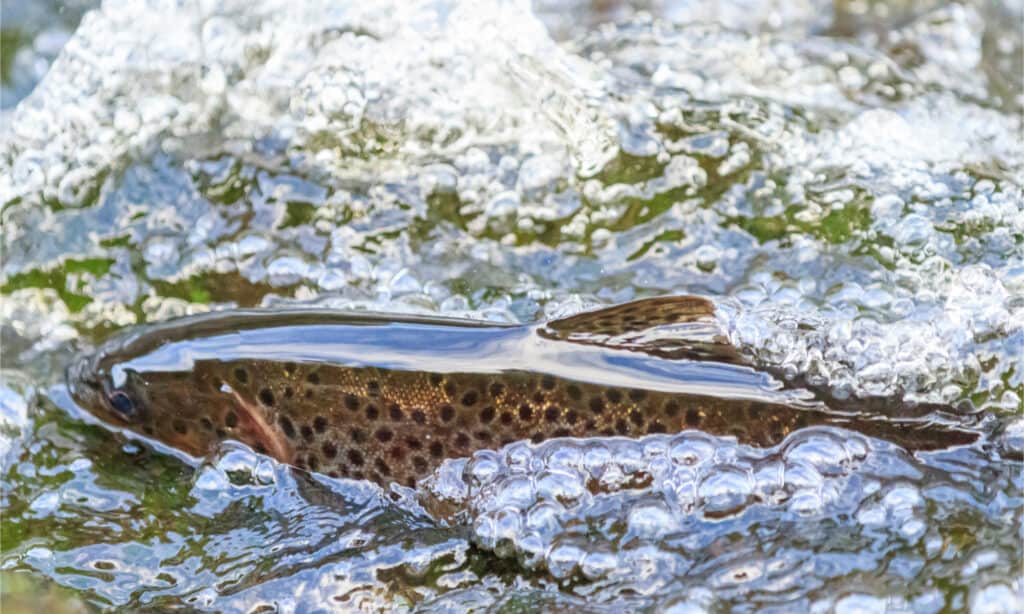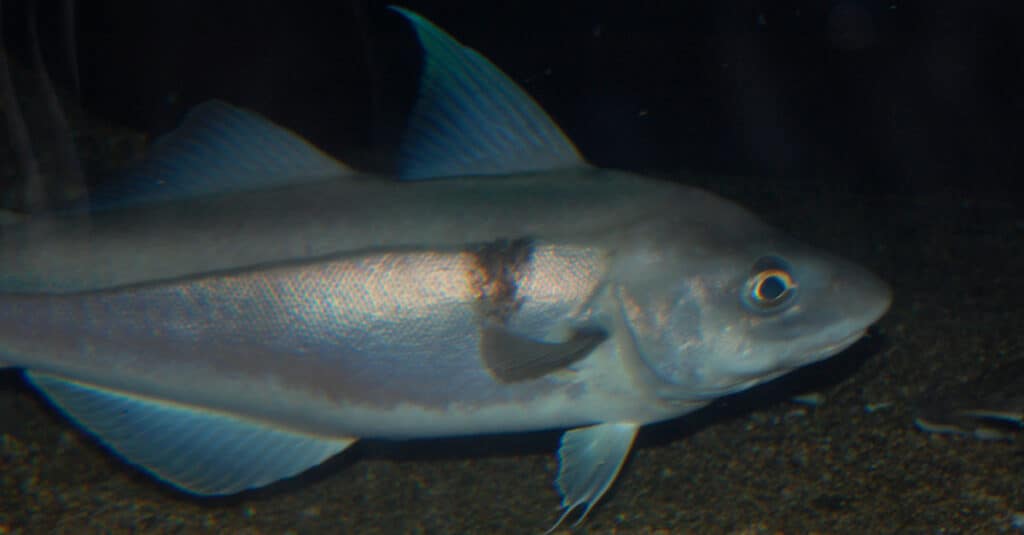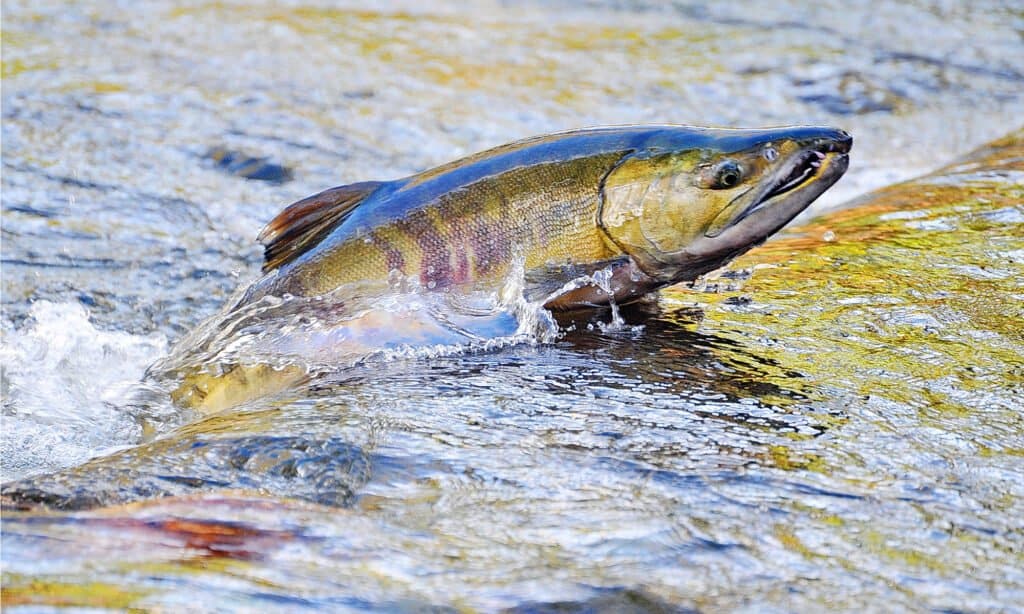Haddock and salmon are just some of the most harvested fish in the world. The haddock comes from a family of true codfish known as the Gadidae, while the salmon comes from Salmonidae, a family of soft ray-finned fishes.
Today, we will discuss some key features that will highlight their differences.
Comparing Haddock vs. Salmon
| Haddock | Salmon | |
|---|---|---|
| Size | Length: 12 to 36 inches Weight: 2 to 40 pounds (0.9 to 18.14 kg) | Length: 18 to 60 inches (1.5 to 5 feet) Weight: 4 to 23 pounds (1.81 to 10.4 kg) |
| Appearance | Elongated bodies with distinguishable coloring, having blackish lines along the back and a marking between the lateral line and the pectoral fin | Long-bodied fish with pointed or hooked beaks, two sets of paired fins on the pelvis and side, and four fins around the body. They can be silvery, pinkish, greenish, or reddish. |
| Habitat | On or near the bottom of lakes and seas | Oceans, seas, lakes, or streams |
| Distribution | Found on both sides of the North Atlantic from Newfoundland, Cape May, New Jersey, Georges Bank, and the Gulf of Maine | Native to the tributaries of the North Atlantic and the Pacific Ocean |
| Diet | These carnivores eat bottom-dwelling animals such as mollusks, crustaceans, worms, sea stars, sea urchins, and even fish eggs | They are carnivores that consume worms, squid, crustaceans, crayfish, sand eels, herring, krill, and other fish |
| Predators | Grey seals, skates, spiny dogfish, and other groundfish such as cod and pollock | Bears, killer whales, sharks, otters, seals, eagles, kingfishers |
| Lifespan | 10 or more years | 2 to 7 years |
The Key Differences Between Haddocks and Salmon
The haddock and the salmon have distinct features. One example is that the haddock is a saltwater fish, and the salmon is an anadromous fish, meaning it can thrive in saltwater and freshwater. However, there are other major differences between the two. These differences include appearance, size, diet, habitat, reproduction, and lifespan.
Let’s discuss these differences in detail!
Haddock vs. Salmon: Appearance

The haddock has a black lateral line running along its white side.
©Solodov Aleksei/Shutterstock.com
One easy way to tell haddocks and salmon apart is their appearance. The two have distinct physical features.
The haddock can be easily identified by its notable feature, the “Devil’s thumbprint,” a dark blotch above its pectoral fin. It has three dorsal fins, two anal fins, a white belly, and a black lateral line running along its white side.
The salmon has a long body with either a pointed or a hooked beak, two sets of paired pelvic and pectoral fins, and four single fins around its body. Its color is silvery with red, blue, green, pink, or purple accents. Some salmon species may undergo physical changes and develop a hump, curved jaw, or even canine teeth during spawning.
Haddock vs. Salmon: Size

Some salmon species can grow as long as 60 inches.
©Chanonry/Shutterstock.com
Another way to tell the two fish apart is by their sizes. Haddocks can only grow from 12 to 36 inches (1 to 3 feet) and weigh 2 to 40 pounds (0.9 to 18.14 kg). Meanwhile, the salmon is a much bigger fish. Some salmon can only reach 18 inches (1.5 feet) and weigh around 4 pounds (1.81 kg). Other salmon species are much bigger, can grow as long as 60 inches (5 feet), and weigh as much as 23 pounds (10.4 kg).
Haddock vs. Salmon: Diet

Haddocks mostly feed on bottom-dwelling animals.
©Steven G. Johnson / CC BY-SA 3.0 – License
The two fish are carnivores, which is why their food sources are approximately the same. However, their diets have some particularities. Haddocks mostly feed on bottom-dwelling animals such as worms, mollusks, crustaceans, sea stars, sea urchins, and fish eggs. Salmon’s diet is more diverse. They feed on worms, squid, crustaceans, crayfish, sand eels, herring, krill, and other fish they can find.
Haddock vs. Salmon: Distribution & Habitat
Haddocks are most common in the Gulf of Maine and across Georges Bank. They are also found on both sides of the North Atlantic. They live in deep waters from 33 to 1,500 feet but most often are found at 300 – 700 feet, yet young haddocks typically thrive in shallow depths.
There’s something unique about salmon habitats, too. They are native to the North Atlantic and Pacific Ocean tributaries. They are anadromous fish, meaning they live in saltwater and freshwater environments. They are born in freshwater habitats and spend their first months or years there before moving to the ocean. They head back to freshwater environments during the spawning season.
Haddock vs. Salmon: Predators
Many animals feed on haddocks and salmon. Haddocks are hunted by spiny dogfish, grey seals, skates, and groundfish species like halibut, cod, pollock, and monkfish. Salmon have predators in saltwater and freshwater habitats. These include bears, killer whales, sharks, otters, seals, eagles, and kingfishers.
Haddock vs. Salmon: Reproduction
Haddocks and salmon use an external reproduction method, but their ways are slightly different. A female haddock will lay its eggs near the ocean floor. Then, the male will fertilize them.
On the other hand, before laying the eggs, a female salmon will dig several depressions (up to seven) using its tail. A male salmon will fertilize the eggs soon after. Once the fertilization process is over, the female will cover the depression.
Haddock vs. Salmon: Lifespan

Salmon have an average lifespan of 2 to 7 years.
©The Old Major/Shutterstock.com
Haddocks and salmon have shorter lifespans compared to other fish. Haddocks mature early and may live 10 or more years. Salmon have an average lifespan of 2 to 7 years; some may stay in freshwater streams for several years before moving to the ocean. Some salmon spend the rest of their lives in the ocean and do not return to freshwater.
Up Next:
- 10 Incredible Salmon Facts
- Red Salmon Vs Pink Salmon: What Are the Differences?
- What Do Salmon Eat? 12 Foods in Their Diet
The photo featured at the top of this post is ©
Sources
- NOAA Fisheries, Available here: https://www.fisheries.noaa.gov/species/haddock
- NOAA Fisheries, Available here: https://www.fisheries.noaa.gov/species/atlantic-salmon
Thank you for reading! Have some feedback for us? Contact the AZ Animals editorial team.






